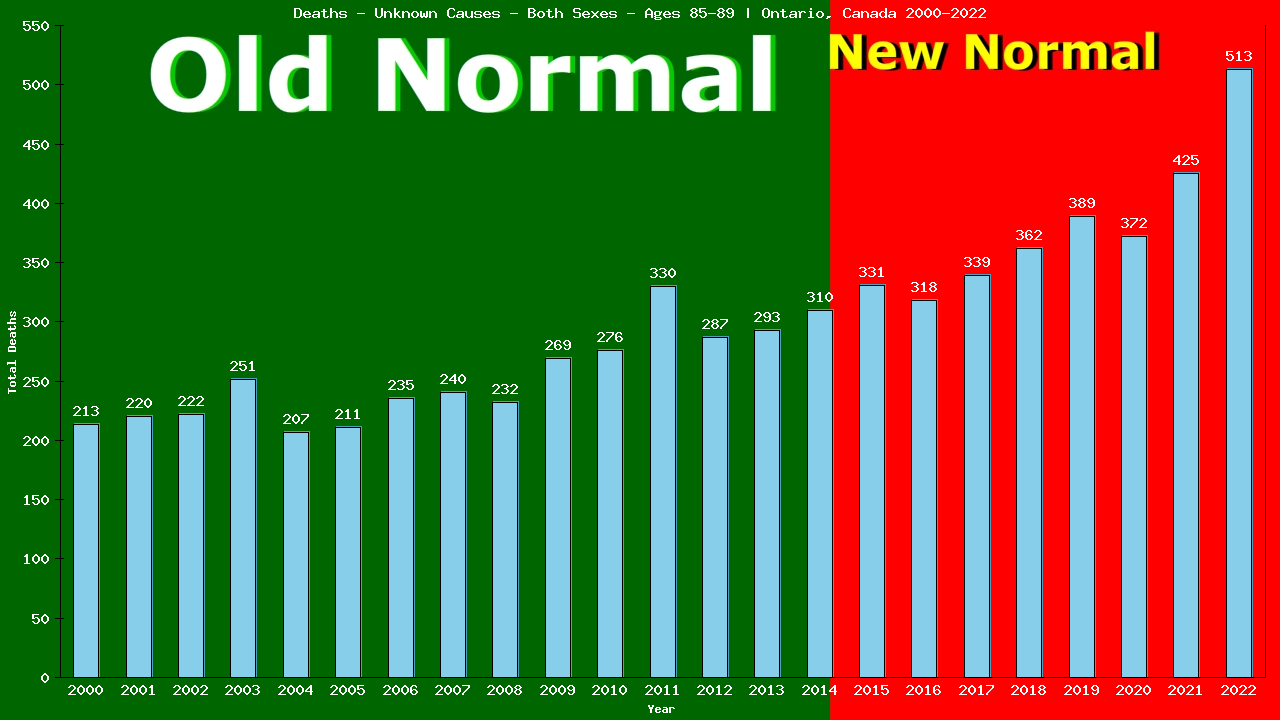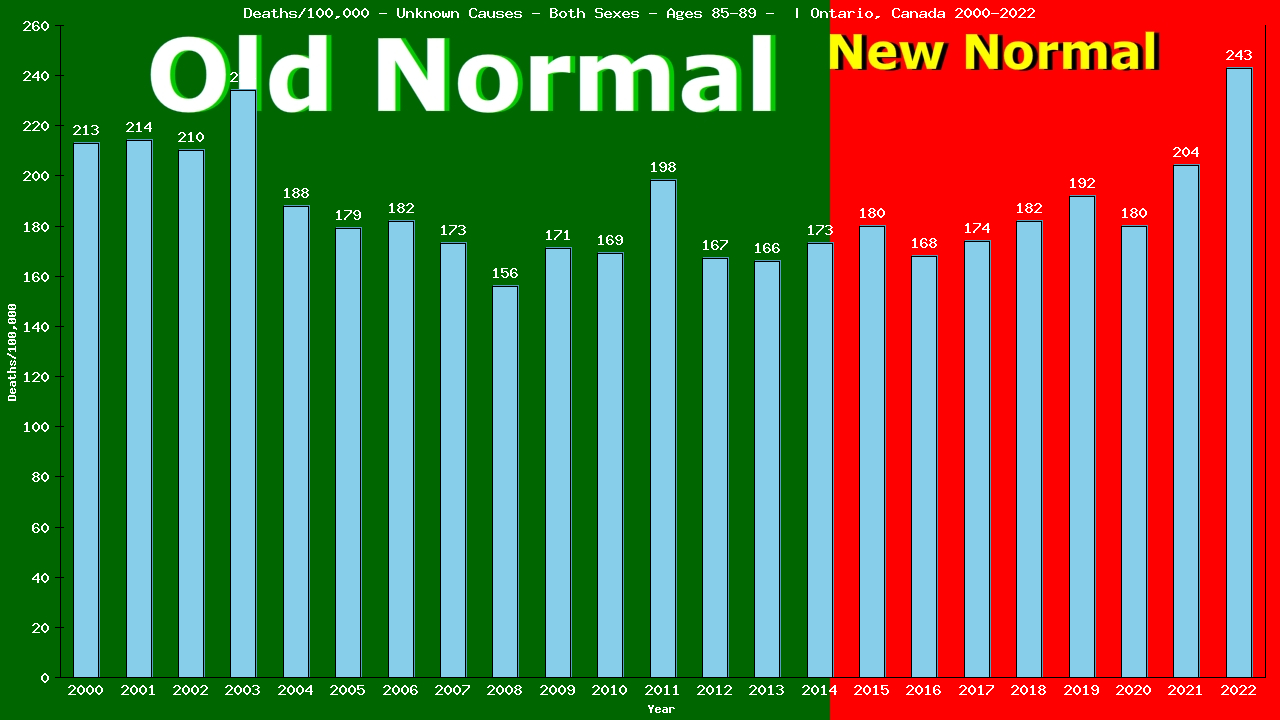Excess Deaths
- Categories:
- Other ill-defined and unspecified causes of mortality (652)

- Unspecified fall (110)

- Exposure to unspecified factor (54)

- Other specified general symptoms and signs (17)

- Cachexia (7)

- Malaise and fatigue (3)

- Other and unspecified convulsions (1)

- Shock, unspecified (1)

- Unspecified event, undetermined intent (1)

- Bradycardia, unspecified (0)

- Pulseless electrical activity, not elsewhere classified (0)

- Syncope and collapse (0)

- Instantaneous death (0)

- Nausea and vomiting (0)

- Coma, unspecified (0)

- Chest pain, unspecified (0)

- Disorientation, unspecified (0)

- Fever, unspecified (0)

- Generalized oedema (0)

- Other chronic pain (0)

- Unspecified haematuria (0)

- Headache (0)

- Hyperglycaemia, unspecified (0)

- Other shock (0)

- Pain, unspecified (0)

- Sequelae of events of undetermined intent (0)

- Deaths: Government of Canada
- Population: Government of Canada
- 2000-2022 Unknown Causes deaths extrapolated from Canadian data
Quick Links
- There were a total of 121,347 deaths in Ontario in 2022
- 20,527 of all deaths were among those aged 85-89
- 7,579 of all deaths were from Unknown Causes
- 848 deaths from Unknown Causes were among those aged 85-89
848 deaths from Unknown Causes were among elderly men and women aged 85-89
2022 vs New Normal™ for elderly men and women aged 85-89 in Ontario
- 848 of 20,527 total deaths were from Unknown Causes
- 4.13% of all deaths were from Unknown Causes
- This is up 84% compared to Old Normal rates.
- 458 of 20,457 total deaths would have been expected under Old Normal conditions.
- 390 excess deaths from Unknown Causes in 2022.
- 70 excess All Cause deaths in 2022.
- 696 excess deaths from Unknown Causes (2015-2022)
- 11,128 fewer than expected All Cause deaths over the first 8 years of Ontario’s New Normal™.
- To show this year’s deaths from Unknown Causes are up 84% compared to Old Normal rates, we need to calculate the rates for both 2022 and for the Old Normal.
Remember, death rates are calculated to answer these questions:
- “How many elderly men and women aged 85-89 were there?” and
- “How many of them died from Unknown Causes?”
The following 2 charts provide this information:
Deaths – Unknown Causes – Both Sexes – Aged 85-89 | Ontario, Canada

Population – Both Sexes – Aged 85-89 – [2000-2022] | Ontario, Canada
![Graph showing Population - Both Sexes - Aged 85-89 - [2000-2022] | Ontario, Canada](/wp-content/plugins/dfuc-display/charts/canada/ontario/2022/all/Both Sexes/85-89-pop.png)
From the charts, we can see that in 2022, 848 of 210,952 elderly men and women aged 85-89 living in Ontario died from Unknown Causes.
848 ÷ 210,952 = 0.00402 (2022 CDR)
Deaths/100,000 Both Sexes 85-89 from Unknown Causes

The table shows there were a total of 4,497 deaths from Unknown Causes among 2,069,646 elderly men and women aged 85-89 living in Ontario in the 15 years immediately prior to the New Normal™.
4,497 ÷ 2,069,646 = 0.00217 (Old Normal CDR)
We can use the Old Normal rate to predict this year’s deaths:
2022 pop X Old Normal CDR = expected deaths
210,952 X 0.00217 = 458 expected deaths
The difference between actual and expected deaths shows lives saved or lost:
848 – 458 = 390
Dividing the actual deaths by the expected deaths gives us the comparative rates:
848 ÷ 458 = 1.8416
This reveals 390 lives lost and is 184.16% of what we expected (an increase of 84%) in deaths from Unknown Causes among elderly men and women aged 85-89 living in Ontario in 2022, as compared to the Old Normal.
This is the same method used by Public Health to calculate the 5-yr CDR (Cumulative Death Rate):
3,305 ÷ 1,380,222 = 0.00239 (5-yr CDR)
210,952(2022 pop) X 0.00239 = 505 expected deaths
The difference between actual and expected deaths:
848 – 505 = 343 or 343 lives lost
Divide actual deaths by expected deaths:
848 ÷ 505 = 1.6718 or an increase of 67%
for deaths from Unknown Causes among elderly men and women aged 85-89 living in Ontario in 2022, as compared to the previous 5 years.
Compare our Old Normal to the 5yr CDR. Does it tell the same story your TV does?
Finally, the same method can also be used to compare our Old Normal rate to the New Normal™ rate:
New Normal™ population X Old Normal rate = expected deaths
1,591,174 X 0.00217 = 3,457 expected deaths
The difference between actual and expected deaths:
4153 – 3,457 = 696 or 696 lives lost
Dividing the actual deaths by the expected deaths:
4,153 ÷ 3,457 = 1.1957 or an increase of 20%
in deaths from Unknown Causes among elderly men and women aged 85-89 living in Ontario in the New Normal™, as compared to the Old Normal.
The world has been led to believe that a deadly pandemic swept the globe beginning in 2020, causing an increase in death rates, especially among the elderly
The data show that death rates began to increase in 2015, immediately upon implementation of the UN’s 2030 Agenda for Sustainable Development, that young adults have experienced ever-increasing death rates since, and that death rates among the elderly have remained relatively stable.
Return to the top of the page to select another age category.
×











